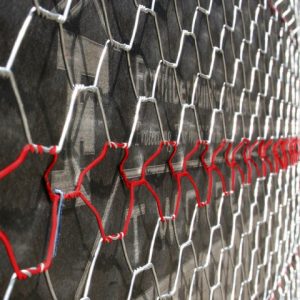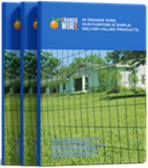You must have observed those cage-like walls around the tennis courts and grounds. The fencing wire used in those walls is called paddle tennis wire. It is a heavy hexagonal wire mesh netting specifically for tennis courts. Paddle wire lasts longer than other wire mesh structures and no other type of wire mesh can replace its performance and durability.

What is a paddle tennis wire?
To understand the function of paddle tennis wire, let’s learn about what is paddle tennis and how the wire “came into being”. Going back decades, two tennis lover friends were keen to play the sport without any restriction. So they came up with the idea of what we call today ” platform tennis”.
The main purpose was to continue playing the sport regardless of weather conditions and the necessity to go outside on tennis courts. As tennis is hard to play on courts during winter, their invention, platform tennis was an easy substitute for traditional tennis sport.
Platform tennis or “mini tennis” can be played within a contained environment without worrying about weather conditions. In this mini tennis, heavy galvanized wire mesh walls surround the area and the players play within the boundaries. They also install glass walls in some courts to protect the inside from extreme weather conditions.
So a paddle wire is a strong 16 gauge hexagonal wire mesh structure that is specifically used in tennis courts. As paddle tennis wire is heavy wire with zinc galvanization, it withstands the damage longer than other wire mesh structures.

What is paddle wire made of?
A wire mesh structure in a platform tennis court must be strong enough to resist both internal and external wear and tear. That is why paddle tennis wire is a heavy hexagonal triple-weaved wire mesh. Triple weaving ensures the longevity of a product.
After weaving, Zinc galvanization protects the structure from rust and weather extremities. As the mesh net is continuously hit by a ball and is also affected by human interaction, galvanization protects it from corrosion.
Mostly, paddle tennis wire is installed outdoors so it must meet specific requirements to guarantee its durability. The specifications of paddle wire are
- It must be a 16 gauge wire to provide secure and strong tennis court walls. A 16 gauge wire is a thick wire.
- Paddle tennis wire is a triple weave hexagonal wire mesh to make sure it lasts longer and can resist more pressure. The heavy woven structure also protects it from rust and damage
- It has 1-inch hexagonal openings.
- After weaving, zinc galvanization protects it from corrosion and damage.

The use of paddle tennis wire on tennis courts
A paddle tennis court has specific dimensions that cover the areas. Hexagonal wire mesh panels surround the whole court. Paddle tennis dimensions include 20-meter length (65ft. 7 inches) and 10-meter width (32ft. 8 inches).
Usually, one paddle tennis wire panel is 72 inches wide and 157.5 inches long. As the wire is strong and heavy, one panel can weigh up to 270 to 300 pounds.
The Paddle tennis wire has no substitute in the same budget. Mesh wires in other sizes and thicknesses may not be able to resist damage as paddle wire. So you must buy them from a good and reliable dealer.
For installment, the paddle wire mesh net doesn’t need the extra cost or separate procedure. Paddle wire panels are installed while constructing the paddle court. The cost of constructing one paddle tennis court can range from $14k -$50k.
What are the other uses of paddle tennis wire?
- Apart from tennis courts, bumper cars in amusement parks use electricity through overhead electrical grids. Those grids have paddle tennis wire in their building structure.
- Artists use Paddle tennis wire to make decorative structures. It doesn’t only provide outdoor aesthetics but is also great for making art and craft.
- Paddle wire is used in gardens to support vines and plants.
- If budget is not an issue and you want durable and strong fencing, paddle tennis wire is the best choice.
- As the structure is heavily woven and the hexagonal size is 1 inch, paddle wires are also fit to use as blocking wires.
- Paddle tennis wire mesh panels are also best for containing bigger animals. That is why they are also installed in zoos.

Is paddle tennis wire a floral wire?
No! They are different in terms of size. For tennis courts, the hexagonal wire mesh is 16 gauge. Whereas, paddle wire used in florals is 22 gauge or 24 gauge. Higher gauges mean thinner wire so paddle wire for florals is a relatively thin wire.
The basic use of floral wire is to tie up weak stems and plants to support their growth. You can customize Floral wires with wire snips. Also, unlike tennis wire that has zinc galvanizing, floral wires have PVC coating. One of the common use of Floral wires is in decorations and craft making.
Is paddle wire the same as padel wire?
Many people confuse paddle and padel. Well, paddle, padel, and platform are different names for the same sport with just a few changes in traditional tennis rules.
The wire for fencing is the same in all three. However, the play courts for all three games are different in size. A padel court is ½ the size of a tennis court whereas platform and paddle courts are ⅓ the size of a traditional tennis court. Also, with the few changes in paddle tennis rules, padel is a Spanish name for a paddle.
The advantages of paddle tennis wire
- As paddle tennis wire is strong, it provides durable fencing.
- Heavy galvanization makes it the perfect wire mesh to resist external damage.
- A Paddle wire has better performance than a common chicken wire.
- For permanence and longevity, you can easily replace the projects that use chicken wire with paddle tennis wire with a little added budget.
- From fencing to Gabion baskets and from DIY projects to gardening tools, paddle wire has wide use. With different gauge sizes, paddle wire is fit for variant projects.
In short, paddle tennis wire is a strong fencing wire that protects the tennis court as well as provides aesthetic to the ground. It is durable, tough, and galvanized hexagonal wire mesh that is also suitable for homes, gardens, and offices.








